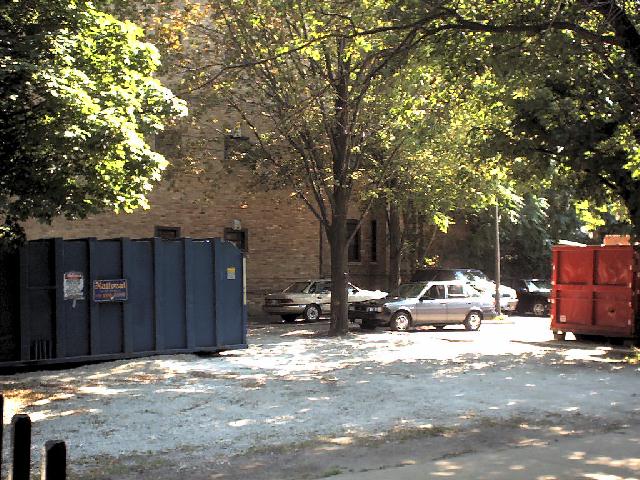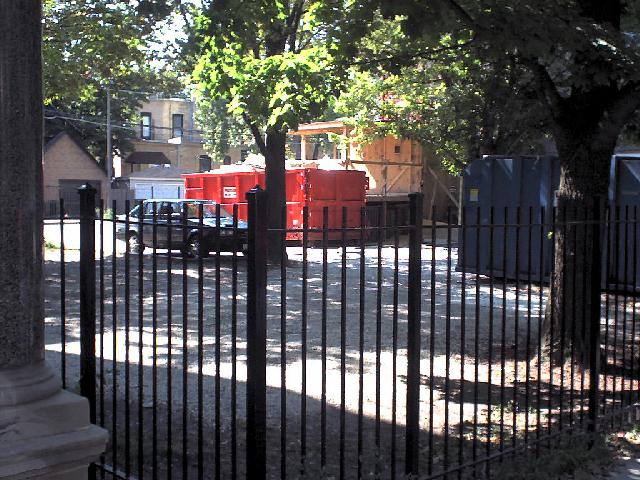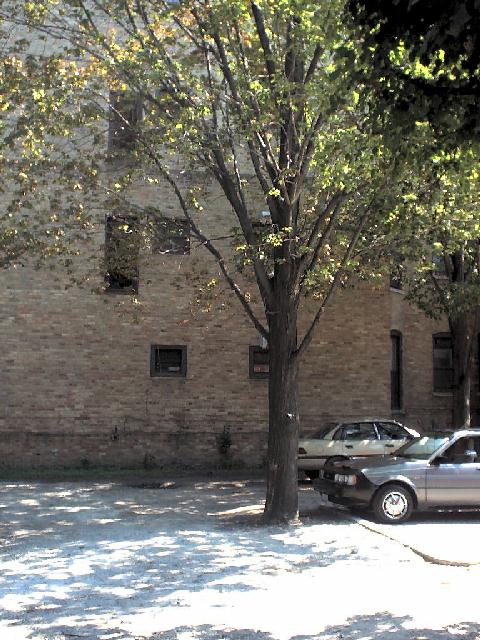|

 - -
 - -
2003 NB |
|
I
visited the site
on a sunny summer Saturday afternoon. I didn't believe the ghost stories--which
said the echoes of screams and gunfire still reverberated from the lot
and dogs walking by on leashes suddenly turned and barked at it--not because
I don't find ghost stories plausible, but because, at the Web site where
I read them, they seemed so contrived. Still, I appreciated the cloak of
sunshine and streams of passersby as I approached the lot where the S.M.C.
Cartage garage once stood. As I walked the length of the sidewalk along
the lot, then walked back, a hush seemed to surround me. The street is
very narrow here, walled off by stone homes on both sides, and the murmur
of pedestrians' voices and whooshing of passing cars seemed to fade. It
wasn't supernatural, but it wasn't just my imagination either. What was
my imagination was that the people now passing the iron fence along the
lot were all beginning to look stout and five or ten years older than they
actually were, like Al Capone himself. I was psyching myself out as I approached
the tree awkwardly sprouting from the middle of the lot, marking the place
where the rear wall of the garage stood. I reached the tree and then flinched
as a man appeared in the window of the adjacent townhouse--no doubt wondering
what some nut with a camera was doing looking at a tree in the middle of
a vacant lot. He looked like Capone, too. On the walk back home I was staring
at the ground, calming myself, when I stopped short at the sight of streams
of red berry juice on the sidewalk, not unlike (it seemed at the time)
the blood in the pictures on the front pages of local newspapers the morning
after the infamous shooting. Now I was really psyching myself out. Before
I got home I was relieved to be confronted by a yellow jacket the size
of a size C battery that hovered right in front of my chest. I froze and
clenched my fist. It was great to be freaking out about something normal
again.
The S.M.C.
Cartage site was appropriately deserted. When I visited, a couple dumpsters
were parked in the lot, bearing debris from a renovation of the seniors
home to the north. For years, of course, the city wanted to forget about
the St. Valentine's Day Massacre and the warehouse where it happened. But
after the tourism binge of the 1990s and yuppification of Lincoln Park,
I was glad, and amazed, that no one had built a gangster-themed diner on
the site (oh great, I just gave some idiot entrepreneur an idea). The lot
is not completely deserted; author Richard Lindberg reports that the site
is visited by thousands of tourists each year. But if the site is not exactly
haunted, it is indeed desolate.
On
the morning of February 14, 1929, seven men--six mobsters of Bugs Moran
and a young optometrist who hung out with them for kicks--had gathered
at the S.M.C. Cartage garage expecting a shipment of bootlegged whiskey
from Detroit. Instead, late in the morning, a police car pulled up outside
and five men got out, three in police uniforms and two in trenchcoats.
Apparently Moran himself had already come and gone from the garage, although
one Web site says he had just pulled up and high-tailed it out of there
when he saw the police car. The three pseudo-policemen went inside and
told Moran's men they were on a raid. The gangsters presumably believed
the visitors, or else they would have put up a fight. As soon as the seven
men were lined up facing the back wall, the two men in trenchcoats entered
with machine guns and opened fire, felling each of their helpless targets.
One report says the pseudo-police then escorted the men in trenchcoats
back out of the garage with their hands up so as to dupe neighbors into
believing the situation was under control. But Lindberg says the cops came
just a few minutes later and discovered the grisly scene of the seven bodies
on the ground. The tethered dog of one of the Moran men was barking hysterically.
Six of the men (including the optometrist) were dead; the seventh briefly
regained consciousness in the hospital long enough to tell police, "Nobody
shot me," and then died.
"Only Capone
kills guys like that!" said Bugs Moran upon hearing of the massacre. His
rival was indeed responsible for the strike that crippled Moran's North
Side gang, but with no eyewitnesses--and with Capone in Florida at the
time--there was no evidence with which to lock anyone up. Capone was never
arrested and the gunmen were not identified for another six years (upon
a jailhouse confession by one of Capone's low-ranking thugs). The massacre
did, however, ruin Capone's popular reputation; the public thought he had
gone too far, and in 1930, he was named "Public Enemy Number One" by the
Chicago Crime Commission.
The S.M.C.
garage on Clark Street was torn down in 1967--some twenty years after an
owner unaware of its history tried to open an antiques store in the building
(more visitors wanted to see the building than his antiques)--but the 414
bricks from the back wall were salvaged by zany promoter George Patey,
who reassembled the the men's room of his Vancouver nightclub in the 1970s.
Apparently the bricks were subsequently being sold via the Web site www.caponewall.com,
but the site went offline in 2003. -NB
-Picture
of crowd gathering outside the S.M.C. garage after the massacre from the
Chicago Historical Society.
-More
about Al Capone and the St. Valentine's Day Massacre from the Chicago Historical
Society
-More
about the St. Valentine's Day Massacre from MysteryNet.com (beware
dubious accuracy)
-More
about the 414 bricks from Mario Gomes' Al Capone museum
-FBI
file on the St. Valentine's Day Massacre
-More
about Al Capone from PBS.org
-See chapter
on St. Valentine's Day Massacre in Return to the Scene of the Crime
(listed here)
by Richard Lindberg. |
|
|